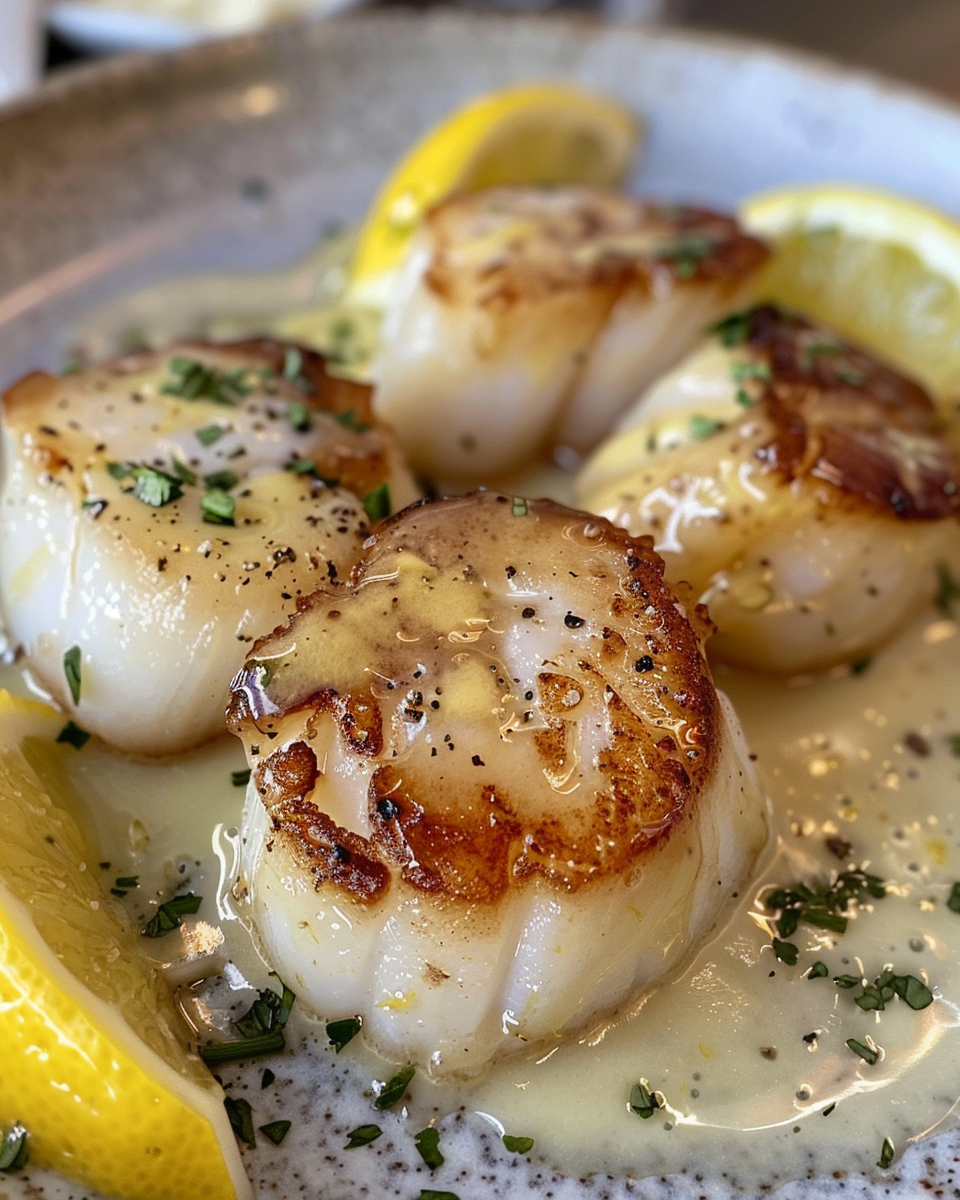Introduction
Creamy Lemon Butter Scallops are a delightful seafood dish that exudes luxury and simplicity. Scallops are renowned for their delicate texture and slightly sweet flavor, making them a sought-after ingredient in both home kitchens and fine dining restaurants. This dish, in particular, balances the richness of a buttery cream sauce with the bright, fresh zing of lemon, creating a harmonious and elegant meal.
Despite their sophistication, this recipe can be made with ease by even the most novice home cooks. The key lies in treating the scallops gently and cooking them just right, ensuring a tender, melt-in-your-mouth experience. This article will guide you through every step, from selecting the best scallops to perfecting the sauce, providing serving ideas, and answering common questions along the way.
Ingredients
To make this indulgent dish, you’ll need the following ingredients:
- Scallops: Opt for fresh, dry-packed sea scallops. These are not treated with chemicals and provide a fresher, sweeter flavor than wet-packed scallops. Wet scallops, which have been soaked in a preservative solution, can release excess moisture when cooking, resulting in a poor sear. Dry scallops are preferable for their superior texture and cooking performance.
- Butter: The backbone of the sauce, butter adds richness and a smooth, velvety texture. Be sure to use unsalted butter to control the saltiness of the dish.
- Lemon Juice: Freshly squeezed lemon juice brings brightness to the sauce, cutting through the richness of the cream and adding a layer of freshness. A small amount of lemon zest can also enhance the citrusy punch.
- Garlic: Finely minced garlic contributes a savory depth to the dish, balancing the sweetness of the scallops and enriching the flavor profile.
- Heavy Cream: Cream is essential for creating the luxurious sauce that envelops the scallops. It adds body and a silky texture to the dish. For a lighter alternative, you can substitute with half-and-half, but the richness may be slightly reduced.
- White Wine or Chicken Broth: Both options are valid, depending on personal preference. White wine adds acidity and depth, while chicken broth keeps the flavor more neutral. Either option works well for deglazing the pan, ensuring that the flavorful browned bits from the scallops are incorporated into the sauce.
- Seasoning: Basic seasonings like salt and pepper are crucial for enhancing the natural flavors of the scallops and sauce. Fresh parsley, used as a garnish, adds color and a mild herbal note to finish the dish.
- Capers (Optional): Capers provide a briny contrast that complements the creamy and citrus elements, adding another layer of flavor. This is an optional ingredient but highly recommended if you enjoy a tangy pop in your dishes.
Instructions: Step-by-Step
This recipe is simple but requires attention to detail to achieve perfection.
Step 1: Preparing the Scallops
Begin by removing the small side muscle from each scallop, if present, as it can be tough and chewy when cooked. Next, pat the scallops dry using paper towels. This step is critical because excess moisture will prevent the scallops from searing properly. A dry surface allows them to develop a golden crust, enhancing both texture and flavor.
Step 2: Searing the Scallops
Heat a large skillet over medium-high heat and add a tablespoon of butter or oil. Once the pan is hot and the butter has melted (or the oil begins to shimmer), gently place the scallops in the pan, ensuring there’s space between them. Overcrowding the pan will result in steaming rather than searing.
Allow the scallops to cook undisturbed for about 2 minutes per side. They should develop a rich golden-brown crust. Flip and repeat on the other side. Once both sides are beautifully seared, remove the scallops from the pan and set them aside on a plate.
Tip for success: A perfect sear depends on a few factors: using a hot pan, not moving the scallops during cooking, and ensuring they are thoroughly dried before searing.
Step 3: Creating the Sauce
With the scallops set aside, lower the heat to medium and add a bit more butter to the skillet. Toss in the minced garlic and sauté until fragrant, being careful not to burn it. At this point, deglaze the pan with your choice of white wine or chicken broth, scraping up any browned bits from the bottom of the pan—these add tremendous flavor to the sauce.
Once the liquid has reduced slightly, pour in the heavy cream and stir to combine. Add a splash of lemon juice and allow the sauce to simmer for a few minutes, thickening as it cooks. If you’ve chosen to include capers, stir them in now.
Step 4: Bringing It All Together
Return the scallops to the pan, nestling them into the sauce. Let them simmer gently in the sauce for about a minute, just long enough to heat them through. Be careful not to overcook the scallops, as they can become rubbery if left too long in the heat.
Finish the dish by garnishing with freshly chopped parsley and a sprinkle of lemon zest. The vibrant green of the parsley and the bright yellow of the lemon zest not only enhance the presentation but also add freshness to the dish.
Serve immediately and enjoy.
Serving Suggestions
Creamy Lemon Butter Scallops pair beautifully with a variety of sides and accompaniments. Here are some ideas to elevate your meal:
- Rice or Risotto: A creamy risotto or fluffy rice helps absorb the delicious sauce, making it a perfect pairing for this dish.
- Mashed Potatoes: Smooth, buttery mashed potatoes provide a hearty base for the scallops and complement the rich cream sauce.
- Pasta: Linguine or spaghetti tossed lightly in olive oil and garlic pairs excellently with the creamy scallop sauce. The pasta acts as a subtle canvas that lets the scallops shine.
- Grilled Vegetables: For a lighter option, serve the scallops alongside grilled or sautéed vegetables like asparagus, zucchini, or spinach, which will balance out the richness of the cream.
- Surf and Turf: Elevate your meal by pairing the scallops with a juicy steak for a luxurious surf-and-turf experience
.
For a lighter presentation, serve the scallops as an appetizer, garnished with fresh herbs and accompanied by a crisp white wine, such as Sauvignon Blanc or Chardonnay.
Conclusion
Cooking creamy lemon butter scallops at home allows you to enjoy a restaurant-quality dish without the hefty price tag. The combination of succulent, perfectly seared scallops with a zesty, creamy sauce creates a dish that is sure to impress at dinner parties or elevate a weeknight meal. The simplicity of the recipe means that anyone can master it with a little attention to detail.
This recipe also offers plenty of room for customization. Try adding different herbs, experimenting with other citrus fruits like lime or orange, or adjusting the richness of the sauce by swapping cream for a lighter alternative. The possibilities are endless, and with practice, you can make this dish your own.
FAQs
Why do my scallops turn out rubbery?
Rubbery scallops are typically the result of overcooking. Scallops cook quickly, usually within 2-3 minutes per side. It’s important to remove them from the pan as soon as they turn opaque and golden brown.
Can I use frozen scallops?
Yes, frozen scallops can be used. Just be sure to thaw them completely in the refrigerator before cooking and pat them dry to remove excess moisture.
What’s the difference between wet and dry scallops?
Wet scallops are treated with a preservative solution that helps them retain moisture but can affect their flavor and texture when cooked. Dry scallops are untreated, fresher, and better suited for searing.
What can I substitute for heavy cream?
You can substitute heavy cream with half-and-half or a non-dairy alternative like coconut cream. However, the sauce may not be as rich and creamy as with traditional heavy cream.
How do I store and reheat leftovers?
Store leftover scallops in an airtight container in the refrigerator for up to two days. Reheat gently in a skillet over low heat to avoid overcooking.
Can I freeze scallops?
It’s best to freeze scallops raw rather than cooked. If freezing cooked scallops, be aware that the texture may change slightly upon reheating.

